Dorn
Children-Babies
The Dorn Method with Children / Babies
A Yes to Self Responsibility and a No to Back Pain
Since the root problem appears to be the traumatic events at, before and after birth it is easy to understand that the treatment of children is not only possible with this gentle approach but indeed necessary.
Children often lack the feeling for their body, different long legs or other imbalances in their structural system and they do not necessarily express these problems with pain because they are still more flexible and relaxed than adults and their energy flows more freely.
However problems are often noticeable in their behaviour like frequent crying, restlessness or the opposite and sleeping problems. Symptoms like Skin diseases and Inflammations, Breathing problems, Hyperactivity or frequent colds may be due to Misalignments and Blockages in the Spinal Column.
Closely related are for example the appearance of polyps and problems in the cervical spine at C2 and C4, Child Migraine often seems connected to a misaligned Atlas (C1) and Bedwetting and Bladder problems are connected to the third lumbar vertebra (L3).
When Kids do not like to walk, prefer to sit or want to be carried around, get tired easily or appear to have a limited range of movement and flexibility then this could be signs of misalignments in the pelvis and spine.
Especially after a complicated birth the often caused subluxations in the cervical spine and the pelvis and hips must be corrected as soon as possible.
Luckily we often do not need to re-balance the whole spine in very young children up to school age because they are still very self-adjustable and flexible at that age but the hips, cervical spine and sacrum need attention also in these kids.
But any problems also in children likely have connections to the spine and should be checked and corrected following the DORN Method principles.
Assessment and practical application
The assessment and re-balancing of possible misalignments in children's body-structures is in principal the same as it is in adults only much more gentle and with more patience. It mainly depends on the child's abilities if it can be treated the same way as an adult. If it understands the exercise and it is cooperating, it can stand on its own and swings the legs freely for example then the procedures can mostly be executed similar to the treatment in adults.
If the child is too small for that then we need some modifications in the procedures as the following descriptions illustrate it.
Different Leg Length in children
The causes are as mentioned often at birth and directly after due to a difficult and traumatic birth experience, unfavourable lifting of the baby at the legs, carrying and moving the baby, one-sided movements, falls and others.
Because of the far reaching consequences for the child the parents, grandparents, babysitters, midwifes, nurses and doctors should be made sensible for this problem.
Leg Length assessment in children
Mother (Parent): The baby lies on its back. The parent stands on the side and places one hand on the stomach area to ensure the back of the baby stays flat on the surface. The hand also has a calming effect.
DORN practitioner: The DORN practitioner stands at the end of the table (at the feet of the baby). He should always explain every step to the parents first and stay in a calming and friendly eye contact to the baby and the parents. When the baby feels trust between the parents and the practitioner then it is more likely to also trust the DORN practitioner.
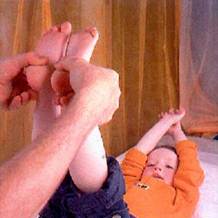
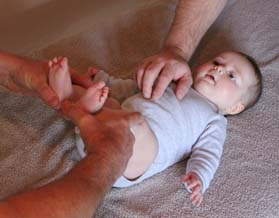
(First Photo courtesy Helmuth Koch)
Re-balancing of the Hip-Joint
Position of Baby and Parent: As before parent on the side touching the baby
Position of the DORN practitioner: The practitioner stands on the same side as the Hip-Joint that will be treated.
Control: After re-balancing of both sides make sure you check the leg length again. Usually they are now already at the same length. If not you may repeat all again once only.
Note: Each DORN practitioner and the parents will develop his/their own style in time.
The parents should be instructed how she can do this on their own and must be encouraged to do it on a very regular basis. There is no need of doing a leg length check prior to the correction. Always both sides must be re-balanced and spending a little time for this the baby will cooperate as it is a play situation. The parent should be a little patient to wait for the right moment doing the re-balancing.
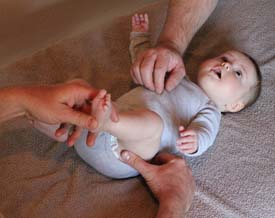
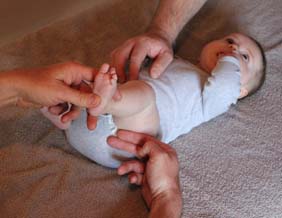
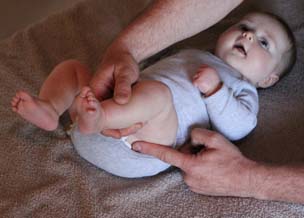
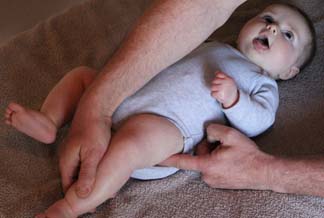
Assessment and re-balancing of sacrum/pelvis
Position of the parents: The parent is usually standing and holding the baby at her stomach area. The baby’s head lies at her chest. One hand is holding the baby’s buttock while the other is stabilizing the upper back and head. The legs are hanging down freely.
Position of DORN practitioner: The practitioner stands opposite of the parent directly behind the baby.
Execution: (sample only) - The re-balancing is done with very gentle pressure using the thumb against the PSIS while the other hand is moving the leg of the same side (or the opposite side) gently back and forth (often only one movement necessary!).
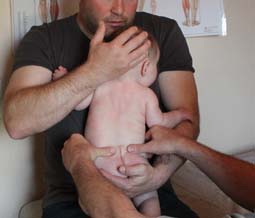
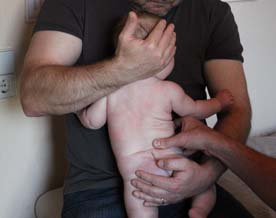
Assessment and re-balancing of Lumbar- and lower Thoracic spine
Positions: As before
Execution: (sample only) -
-
The little Spine is palpated very gentle left and right of the spinous processes from the sacrum upwards to the lower thoracic spine (middle of the back) pretty much the same way as with adults. It is often best to use the thumbs for this.
-
If any deviation of the vertebra position is found then a re-balancing is attempted. The procedure is done in principal the same way as with adults. The swinging motion of the leg is done by the parent or the practitioner. Gentle thumb counter-pressure is helping to re-balance the spine while the leg on the same side is moved back and forth (often only one movement necessary!).
Assessment and re-balancing of the upper Thoracic Spine
Position: The parent stabilizes the baby at the lower thoracic and lumbar spine so the practitioner can reach the upper parts for palpation.
Execution: (sample only) - The practitioner is palpating the spine from the lower thoracic area upwards left and right next to the spinous processes and checks for any abnormalities and deviations. It is often best to use the thumbs for this.
Un-balanced areas are re-balanced with very gentle counter pressure against the processes while one arm of the baby is moved forwards and backwards in a swinging motion by the parent or the practitioner (often only one movement necessary!). It is either the opposite arm that is moved or the arm at the same side to be re-balanced.
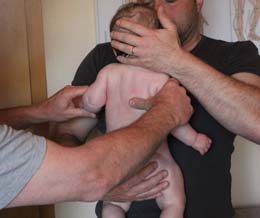
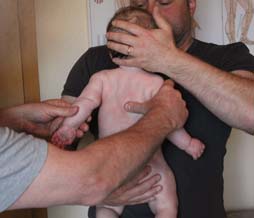
Assessment and re-balancing of the Cervical Spine
Position of Parent and Baby: The Baby lies on its back on the treatment table (any table will do). The parent holds and calms the baby by placing her hand onto the baby's stomach.
Position of the DORN practitioner: The practitioner stands at the Head (above) of the baby
Execution: (sample only)
The practitioner takes the head of the baby in both hands; ideally the baby cuddles into his hands.
With his fingers the practitioner is palpating the cervical vertebra and checks if they are in their proper position. The therapist should be skilled and gentle as this may be uncomfortable if any im-balance exist.
The re-balancing is done by applying very careful and gentle pressure onto the spinous or transverse processes while the head is moved (rocking motion) from side to side (No-No Movement) by the practitioner.
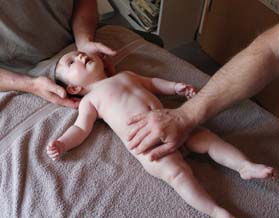
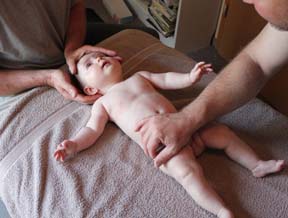
Note: Always work in cooperation with the Parents. Be very careful and gentle. Do not overdo it. Do not cause Pain to the Baby.
Note: The above information is not intended as therapy instruction. Never use the Dorn Method on others unless you are properly trained and licensed to do manual therapy.
Attention: The discribed procedures how DORN is used with children and babies must not be done as therapeutic manipulative manual therapy but should be done only as selfhelp demonstration for the parents that are instructed how to do the procedures with their own children / babies.
Copyright: Thomas Zudrell ©
» Continue exploring the DORN Method: DORN and animals
New: DORN selfhelp exercises webapp
NOTE: Never try to use the DORN Method on other people without proper training best conducted by an authorized DORN Method Instructor. Although the DORN Method and the Self Help Exercises are very safe if done correctly, the DORN practitioner is not responsible for any consequences resulting from the application during the manual session and Selfhelp exercises. In any case it is advised to consult your doctor first because health problems and back pains may have other causes than misaligned joints and vertebrae and should be checked by a trained medical doctor or other healthcare professional. The DORN Method has certain Limitations that must be cleared prior to any practical application! Remember: The DORN Method is NO Replacement for any other form of medical or non-medical treatment but it can be a very effective complement in an integrative medical system.
©copyright: AHHAI - Thomas Zudrell
Imprint - Contact - Links
Powered by "The Force"